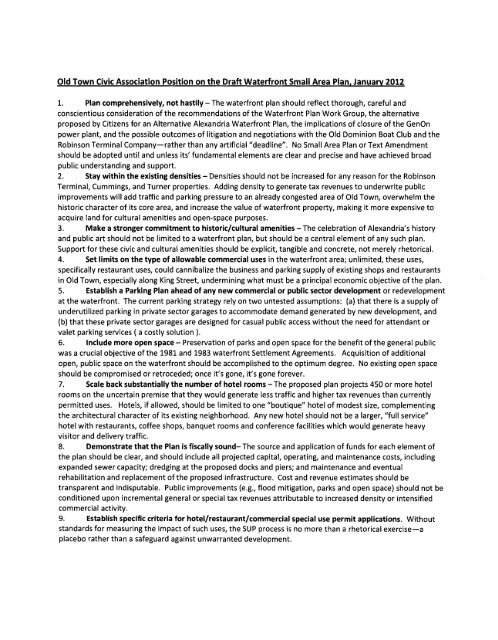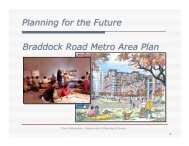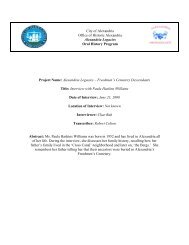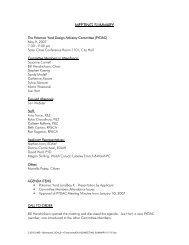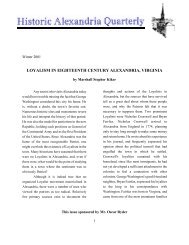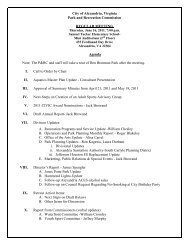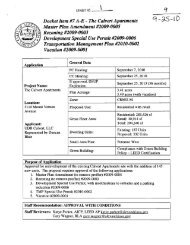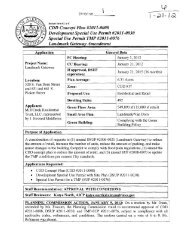consideration - City of Alexandria
consideration - City of Alexandria
consideration - City of Alexandria
You also want an ePaper? Increase the reach of your titles
YUMPU automatically turns print PDFs into web optimized ePapers that Google loves.
Old Town CivicAssociation Position on the Draft Waterfront Small Area Plan. Januarv 2012<br />
1. Plan comprehensively, not hastily - The waterfront plan should reflect thorough, careful and<br />
conscientious <strong>consideration</strong> <strong>of</strong> the recommendations <strong>of</strong> the Waterfront Plan Work Group, the alternative<br />
proposed by Citizens for an Alternative <strong>Alexandria</strong> Waterfront Plan, the implications <strong>of</strong> closure <strong>of</strong> the GenOn<br />
power plant, and the possible outcomes <strong>of</strong> litigation and negotiations with the Old Dominion Boat Club and the<br />
Robinson Terminal Company-rather than any artificial "deadline". No Small Area Plan or Text Amendment<br />
should be adopted until and unless its' fundamental elements are clear and precise and have achieved broad<br />
public understanding and support.<br />
2. Stay within the existing densities - Densities should not be increased for any reason for the Robinson<br />
Terminal, Cummings, and Turner properties. Adding density to generate tax revenues to underwrite public<br />
improvements will add traffic and parking pressure to an already congested area <strong>of</strong> Old Town, overwhelm the<br />
historic character <strong>of</strong> its core area, and increase the value <strong>of</strong> waterfront property, making it more expensive to<br />
acquire land for cultural amenities and open-space purposes.<br />
3. Make a stronger commitment to historic/cultural amenities - The celebration <strong>of</strong> <strong>Alexandria</strong>'s history<br />
and public art should not be limited to a waterfront plan, but should be a central element <strong>of</strong> any such plan.<br />
Support for these civic and cultural amenities should be explicit, tangible and concrete, not merely rhetorical.<br />
4. Set limits on the type <strong>of</strong> allowable commercial uses in the waterfront area; unlimited, these uses,<br />
specifically restaurant uses, could cannibalize the business and parking supply <strong>of</strong> existing shops and restaurants<br />
in Old Town, especially along King Street, undermining what must be a principal economic objective <strong>of</strong>the plan.<br />
5. Establish a Parking Plan ahead <strong>of</strong> any new commercial or public sector development or redevelopment<br />
at the waterfront. The current parking strategy rely on two untested assumptions: (a) that there is a supply <strong>of</strong><br />
underutilized parking in private sector garages to accommodate demand generated by new development, and<br />
(b) that these private sector garages are designed for casual public access without the need for attendant or<br />
valet parking services ( a costly solution ).<br />
6. Include more open space - Preservation <strong>of</strong> parks and open space for the benefit <strong>of</strong> the general public<br />
was a crucial objective <strong>of</strong> the 1981 and 1983 waterfront Settlement Agreements. Acquisition <strong>of</strong> additional<br />
open, public space on the waterfront should be accomplished to the optimum degree. No existing open space<br />
should be compromised or retroceded; once it's gone, it's gone forever.<br />
7. Scale back substantially the number <strong>of</strong> hotel rooms - The proposed plan projects 450 or more hotel<br />
rooms on the uncertain premise that they would generate less traffic and higher tax revenues than currently<br />
permitted uses. Hotels, if allowed, should be limited to one "boutique" hotel <strong>of</strong> modest size, complementing<br />
the architectural character <strong>of</strong> its existing neighborhood. Any new hotel should not be a larger, "full service"<br />
hotel with restaurants, c<strong>of</strong>fee shops, banquet rooms and conference facilities which would generate heavy<br />
visitor and delivery traffic.<br />
8. Demonstrate that the Plan is fiscally sound- The source and application <strong>of</strong> funds for each element <strong>of</strong><br />
the plan should be clear, and should include all projected capital, operating, and maintenance costs, including<br />
expanded sewer capacity; dredging at the proposed docks and piers; and maintenance and eventual<br />
rehabilitation and replacement <strong>of</strong> the proposed infrastructure. Cost and revenue estimates should be<br />
transparent and indisputable. Public improvements (e.g., flood mitigation, parks and open space) should not be<br />
conditioned upon incremental general or special tax revenues attributable to increased density or intensified<br />
commercial activity.<br />
9. Establish specific criteria for hotel/restaurant/commercial special use permit applications. Without<br />
standards for measuring the impact <strong>of</strong> such uses, the SUP process is no more than a rhetorical exercise-a<br />
placebo rather than a safeguard against unwarranted development.


